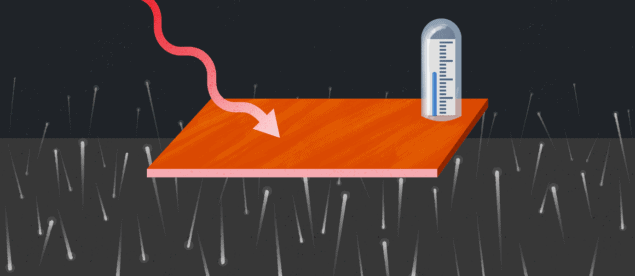Quantum calorimeter is as precise as nature allows
30 Jan 2020
How do you define the position of something that won’t stay still? This is the problem physicists face when they try to measure a system’s properties with such precision that quantum effects contribute a significant source of uncertainty. Whatever the variable, and however refined the instrument, there comes a point at which the signal is lost in the noise.
A quantum calorimeter developed by researchers at Finland’s Aalto University School of Science and Lund University, Sweden, defines this limit for an ideal thermometer by measuring fluctuations in the electron temperature of a copper nanowire. The team found that the intrinsic thermal noise in the wire is small enough for them to detect a single microwave photon. As well as enabling new experiments in quantum thermodynamics, the device could be used to make noninvasive measurements of quantum systems such as qubits in superconducting quantum computers.
To work out where the measurement limit lies for a thermometer, Bayan Karimi and colleagues built a calorimeter sensitive enough to measure the tiny but unavoidable energy fluctuations that affect every system warmer than absolute zero. The team’s device consists of a copper nanowire 1 µm long and 35 nm wide, deposited on an insulating substrate. A tunnel junction at one end of the copper wire, and a direct contact 50 nm along its length, allow current to flow into an aluminium circuit that becomes superconducting at the temperature range studied (about 10–250 mK). At the other end of the wire, a second tunnel junction lets the researchers inject high-energy electrons so they can also study the system in an out-of-equilibrium state.
Because a tunnel junction’s conductance varies with the energy distribution of the electrons, the researchers measure the voltage across the circuit to find the temperature of the 108 or so electrons in the copper wire. Averaged over time, a plot of this temperature would be a smooth line – flat for a system in equilibrium, sloping for a system out of equilibrium.
Different types of fluctuation
Look more closely, however, and a different picture emerges. While the energy in the system may stay the same overall, it is constantly being exchanged between electrons in the copper wire and random lattice vibrations in the wire and underlying substrate. At the 10 kHz sampling rate that Karimi and colleagues achieve with their device, the inconstant share of energy held by the electrons translates into a fluctuating electron temperature. In the out-of-equilibrium experiments, an additional source of fluctuations arises from the random arrival times and energies of the electrons injected into the nanowire.
These fluctuations are different from the instrumental noise that ambitious metrologists deal with daily. By isolating and characterizing temperature variations that originate in their experimental apparatus, the researchers confirm that their measured electron-energy fluctuations represent a fundamental and inescapable limit on temperature sensitivity. They are inherent to the system and mask any temperature changes smaller than a certain size.
The good news, the team found, is that even faced with this hard limit on sensitivity, the noise level is low enough for energy changes as small as a single microwave photon to be detected – without disturbing the system in the process. Since this is the amount of energy that separates qubit states in superconducting quantum computers, the researchers think their calorimeter could provide a non-invasive way of monitoring relaxation and decoherence processes.
Clever design
“The problem is that most thermometers at the nanoscale heat the system, and thus determining the temperature might destroy the delicate quantum features,” says Sebastian Deffner of University of Maryland, Baltimore County (UMBC) in the US, who was not involved with the project. “The authors of this paper seem to have found a clever design that works around this issue. If this thermometer is now taken up by others (if it becomes the iPhone of quantum thermometers), then this may be a very, very important breakthrough.”
Being able to spot such tiny temperature changes could also enable advances in more fundamental physics, as there are still significant gaps in our understanding of how energy relates to quantum mechanics.
“Thermodynamics is something that is largely missing from our understanding of the quantum world,” says Jukka Pekola, who leads the team at Aalto. “Our detector could look at the heat and temperature changes determined by the tiniest increments: quanta that mediate energy exchange. Approaches like stochastic thermodynamics could then be applied in the quantum regime, for the first time ever, by directly measuring the heat.”
FROM PHYSICSWORLD.COM 31/12020

Δεν υπάρχουν σχόλια:
Δημοσίευση σχολίου